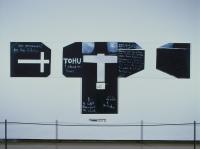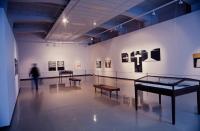Parihaka: The Art of Passive Resistance
This nationally significant exhibition commemorates and explores one of the major historical events in the history of Aotearoa New Zealand; the invasion of Parihaka, Taranaki by Pākehā soldiers in 1881.
Parihaka: The Art of Passive Resistance marks a new millennium. A partnership between City Gallery and the Parihaka Pā trustees, and over seven years in the making, it explores the legacy of Parihaka and its leaders, Te Whiti o Rongomai and Tohu Kākahi. Director Paula Savage says, ‘You couldn’t do this story unless you did it with the utmost integrity. The story of Parihaka has got mythic status in the New Zealand consciousness’ (Evening Post, 24 August 2000).
From founding Parihaka in the 1860s until their deaths in 1907, Te Whiti and Tohu led their people in their struggle to retain their land, culture, and independence. They waged a campaign of non-violent resistance against the Crown during and following the Taranaki Land Wars, as their lands were surveyed and confiscated, and leased, sold, and given to settlers. Their people ploughed, fenced, and barricaded their lands. Te Whiti said, ‘Go put you hands to the plough, look not back. If any come with guns and swords, be not afraid. If they smite you, smite not in return.’ Te Whiti’s teachings are symbolised by the raukura, the white feathers of peace.
Despite their non-violence, on 5 November 1881, Native Minister John Bryce led a militia of 1500 volunteers and settlers against them and their unfortified Pā. A five-year military occupation ensued. Laws were passed so Te Whiti and Tohu and their followers could be held indefinitely without trial in prisons throughout the country. Hundreds were incarcerated in South Island prisons—some for up to eighteen years. Many died there.
For the show's Saturday-morning opening, a crowd of 2,000, many wearing the raukura, gather in Civic Square awaiting the karanga. John Searancke said, ‘Half of Taranaki was there, and a lot of other tribes as well. It was something for the history books.' At the opening, UNESCO presents peacebuilder awards to two kuia, Parekaitu Ito and Rangikotuku Rukuwai, guardians of the Parihaka meeting houses.
The show encompasses historical material, previously existing works, and new commissioned works.
The historical component includes photos of Te Whiti and Tohu taken during their South Island imprisonment, and examples of their speeches and waiata. The Pā's history is illustrated with early watercolours, photographs, artefacts, and ornaments.
The pre-existing works include Fiona Clark’s photo, The Memorial of Te Whiti o Rongomai at Parihaka, Dawn, 6am, 6 November 1981, that was taken on the centenary of the invasion of the Pā. Rangi Kipa's Recti si Possimus Non Quonuque si Nodo (Take by legal means or by any means necessary) (1999) consists of a guillotine and a set of stocks. He says, ‘the stocks represent the legal constraints and measures used by colonisers to immobilise Māori. The guillotine embodies the way settler attitudes affected Māori. It was a deathtrap.’ Other works were made for the 1981 Parihaka Centennial Exhibition and Art Auction at the Govett-Brewster Art Gallery, New Plymouth—including Stanley Palmer’s Parihaka Flag, Nigel Brown’s Village of Peace, and Barry Brickell’s Kūaha Doorway.
Writer Dick Scott is a key figure. His book Ask that Mountain (1975) brought the Parihaka story to a wide national audience, including artists and writers. One of the most famous Parihaka works is Michael Smither’s painting which appears on the cover—it features in the show. The show also includes Marti Friedlander's photomural of the forlorn village. She took the photos in 1967, when she accompanied Scott on a visit.
Scott’s earlier book on Parihaka influenced the young exhibitions officer, James Mack. In 1973, he curated the pioneering show, Taranaki Saw It All: The Story of Te Whiti o Rongomai of Parihaka, for Waikato Museum. ‘I was told to do an exhibition on Te Whiti o Rongmai and Parihaka,’ says Mack. ‘I had no idea who he was, neither did I realise the research I was about to embark on would change my life.’ Taranaki Saw It All began a history of artworks responding to Parihaka. Our show acknowledges a strong connection to Mack’s, incorporating several important works originally commissioned for it: Colin McCahon’s Parihaka Triptych (1972) and Ralph Hotere’s text-based Te Whiti series.
The Parihaka Triptych is shown with nine other works from McCahon’s Parihakaseries for the first time. Similarly, Gordon Walters's paintings Te Whiti and Tohu (1973) are also presented together for the first time. Te Whiti (1964), Walters's first koru painting—he grew up on Te Whiti Street in Kilbirnie—may be the first work by a contemporary New Zealand artist to refer to Parihaka. Walters is the only artist in the show whose works were not commissioned for this show, Mack's show, or the Centennial show.
A $75,000 Lottery General Millennium Grant enables the Gallery to commission new works from fifteen Māori, Pacific Island, and Pākehā artists. The works will be gifted to Parihaka after the show. Some of the artists whakapapa to Parihaka. Painter Darcy Nicholas's great-grandparents were among those who suffered land confiscation and imprisonment. Sculptors Fred Graham and his son Brett Graham are descended from members of the Tekaumārua (the Māori King's council), who resided at Parihaka in the 1870s. The burial of their tīpuna at Parihaka connects the Grahams to Parihaka. John Pule’s painting The Prophets: Showing Us How Far We Must Go to Achieve Human Freedom (2000) establishes a link to Parihaka through migration. The ship that brought Pule’s family from Niue to New Zealand in the 1960s was named after Māui Pōmare, a child at the Parihaka Pā in 1881 who later became the minister of cultural affairs. ‘I wanted to use the name of the ship as my link to Parihaka’, Pule says.
Photography figures large. Natalie Roberston’s night photos of street signs, Te Whiti Rd: U23/4.2 (1999) and Tohu Place: P19/6.2 (2000), nod to Walters. Laurence Aberhart’s photo series The Prisoner’s Dream (1999–2000) consists of views taken from inside the ruins of the jail on Ripapa Island in Lyttelton Harbour, where Parihaka prisoners were incarcerated. Anne Noble enlarges details from photos taken during the Parihaka invasion. While she decided against working with images of Mount Taranaki, 'I noticed this little irony, that under this great cone were these miniature cones which were the tents of the constabulary’, she explains. She also enlarges details from a 1901 photo of children at Parihaka.
The show is not without conflicts. Selwyn Muru pulls out, allegedly protesting the commission of a work by Tūhoe activist-artist Tame Iti. Iti's installation finds a musket, two bullets, and an albatross feather laid on a table. A sequence of golf balls and mirrors are arranged beneath the table, adding to its symbolism.
Among the younger artists are painters Shane Cotton and Seraphine Pick, then both thirty-six. Cotton makes ten small paintings featuring an albatross, referring 'to a famous story told by Tohu about an albatross that had flown down into the village sanctioning the spirit among the people and symbolising peace’. Pick’s narrative painting Riki and Ruru (2000) combines images drawn from various sources, including early colonial photos and paintings, especially the work of Aporo, a Māori painter of the time. She says, ‘As a European it’s quite a responsibility dealing with another’s family and history’ (The Press, 30 August 2000). Pick's painting is used as the show’s poster image while Tony Fomison’s 1962 portrait of Te Whiti appears on the book’s cover (it had also been the cover image for the catalogue of the Centennial show). The choice of Pick’s and Fomison’s artworks to publicise the exhibition draws some criticism, as both are Pākehā.
The public programme is organised by poet Roma Pōtiki. It includes talks by Dick Scott, James Mack, and historian Paul Moon. Six young kaiārahi (guides) from Parihaka give weekend talks. The final event—Supporting the Kaupapa: A Concert for Parihaka—takes place in Civic Square. A CD is also available, featuring the Tim Finn song 'Parihaka', which was composed for the 1981 centennial, along with other songs and readings of commissioned poems.
The book Parihaka: The Art of Passive Resistance is launched as the exhibition closes. It begins with a 10,000-word history of Parihaka written by Hazel Rizeborough in collaboration with Parihaka representatives. The book is a joint-winner in the History and Biography category at the 2001 Montana New Zealand Book Awards. However, novelist Kelly Ann Morey, in her Listenerreview, says, like the exhibition, it ‘ploughs remarkably little new ground’; she calls it an example of ‘studious biculturalism’.
Saatchi and Saatchi create the ad campaign. Directed by Len Cheeseman, their bold TV ad wins seven awards, including a Gold at the 2001 Axis Awards. They also develop a dedicated website for the show.
In Landfall, Laurence Simmons says the show's institution-community partnership model provides a path for future curatorial practice. He says, ‘We are only at the beginning of an understanding of this "politics of memory" and Parihaka: The Art of Passive Resistance shines like a beacon at the beginning of the twenty-first century to guide us towards a new shape of knowing.’ However, in Tū Mai, Julie Paama-Pengelly (Ngāi te Rangi) is critical of the show's ‘good intentions’. She writes, ‘The exhibition becomes one of western fine art at one end, complemented by historical documentary at the other end. This reinforces the nostalgic, romantic journey the exhibition tends to project, the great utopian dream against "heinous injustice", desensitising the historical with beautiful paintings and poetry.’ However, she acknowledges the gift of the new works to Parihaka and sees the show's bicultural partnership model as one worth building on.
Over 55,000 visitors see Parihaka: The Art of Passive Resistance. Twenty-one percent are Māori. The show wins the 2001 Premier Creative Places Award. The commissioned works are later shown at Waiwhetū Marae, Lower Hutt, on Waitangi Day. When the show is presented at Dunedin Public Art Gallery, a new component is added, telling the story of the Māori prisoners taken from Parihaka to Dunedin.
Text extracted from the City Gallery Wellington website.








![[Te Whiti]](https://www.mccahon.co.nz/sites/all/files/styles/pi_thumbnail/public/images/cm000134.jpg?itok=hSyo-O64)



